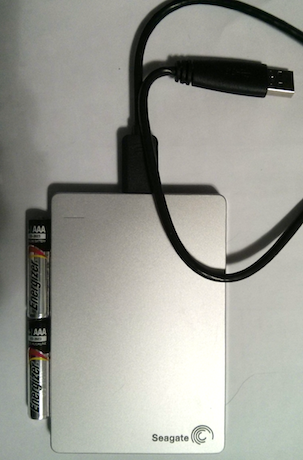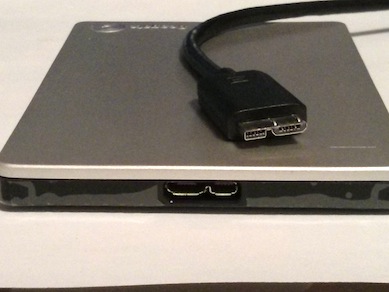It’s been a long time since I’ve had the pleasure of being introduced to a consumer device that was 100% brain dead easy to use. This review is on the Seagate Slim Mac 500GB USB 3.0 portable external hard drive and is intended to compliment existing reviews that go into all the technical details. This drive is extremely portable in the sense that it’s just a little bit smaller length-wise than a typical smartphone and about the same thickness.
Full disclosure: I have not received anything from Seagate for this endorsement. Which is too bad actually because I really like the Slim Mac so far.
Testing machine specs. I tested it on Mid 2012 Macbook Pro Retina running OS X 10.8.5 and the factory SSD.
- 2.6 GHz i7
- 16 GB 1600 MHz DDR3
- 512 GB SSD
Type of drive. It’s a hard drive not a solid state drive (SSD). So it has a spinning disk inside and those are inherently slower than SSDs although they are also less expensive for now. Just glancing around I didn’t see any read/write performance specs on the drive. So, maybe my real-world tests below will give some indication of what it’s really capable of as compared to the theoretical performance of USB 3.
Why only 500GB? On a dollar-per-gigabyte scale it is typically more economical to by a 1-terabyte drive. However, I chose a smaller capacity drive for two reasons. First, I wanted something very portable and light. Slim Mac meets that criterion hands down. Second, I plan to only use it for emergencies like when I accidentally loose a file or my main hard drive completely fails so I don’t really need a full terabyte.
First time usage was like a dream. Here’s how easy it was to use this device.
- Plugged the device into my Mac.
- Instantly I got the Time Machine window.
- I selected the Seagate Drive as my target
- I selected the option to start backing up.
Elapsed time to complete those four steps was around 15 – 20 seconds. Yep, you heard that right.
Actual Time Machine Performance. Important note: your mileage may vary (YMMV) in that every machine will back up differently. My initial full backup size was 41 Gigabytes. In an unscientific eyeballing, it took roughly 35 minutes for this to complete. But I figured since it was a real life backup scenario that the numbers would be fairly reflective of what others could expect on a similar machine. As far as I could tell there was no compression on the disk as the physical size of the back on disk was 40.71 GB. This works out to 1.17 Gigabytes per minute. More on this speed below.
Copy-and-Paste Performance. For comparison, I took an application directory that was 3.61 GB and 25,195 files then copied that from my Mac to the Seagate. I ran the test twice and disconnected the USB cable in between tests. This took approximately 47 seconds both times. That works out to about 0.0768 Gigabytes/sec, or roughly 4.608 Gigabytes per minute, which is nowhere near the USB 3 spec but probably realistic for most real-world copy-paste usage scenarios that you might run into. Without getting too much into the details, read and write speeds vary by the number, physical size and types of files being copied such as images versus executables versus text files.
Packaging. Cardboard box with an easy to open plastic clamshell inside that held the drive and the USB cable. I simply cut the security seal and had the drive in my hand in about 15 seconds. There was no futzing around to get it out of the clamshell. For some unknown reason, some small portable drives come in what appears to be ballistic plastic that would survive a full-on zombie assault during World War Z. Not this drive, it was well packaged and a breeze to remove.
Casing and smudges. The top of the drive appears to be brushed aluminum and the bottom portion is encased in black plastic. I tried to smudge it up with peanut butter laden fingers which I had from eating my lunch. But the peanut butter wiped right off and the aluminum hid the smudges fairly well. I even tried to scratch it up with my finger nail and wasn’t able to make any permanent marks.
Size and Weight. It fits nicely in the palm of your hand. Dimensions are 0.38 inches thick which is about as tall as a AAA battery. It’s 2.99 inches wide and 4.47 inches long. So, it’s just a little bit longer than 2 AAA batteries stack end-to-end. It weighs a tiny 5.28 ounces, or a little over one quarter can of beer (or soda!). It’s roughly the same width and thickness of my Android Nexus 4, and about 3/4 of an inch shorter. So, if you like packing ultra-light this drive shouldn’t be a problem.
Interface. SuperSpeed USB 3.0 spec’d at a “theoretical” 5 Gigabits/sec (not Gigabyte!) and is USB 2.0 compatible at a reduced speed.
- 5 Gigabits/sec = 0.5821 Gigabytes/sec
- 34.926 Gigabytes per minute
Okay, now that that’s out of the way you will probably never see these speeds when backing up your data or copying and pasting in real life so don’t get too excited. Real life usage will be much less due to data transmission overhead, USB cable issues, USB hardware, computer bus, hard drive and/or operating system. Different laptops will see different speeds. I also read there have been complaints that USB 3 drives often experience USB 2 speeds. Like I said before: YMMV.
So-so. The drive uses a female USB 3 “Micro-B” connector. The included cable has a USB 2-style connector on one end and a Micro-B connector on the other. So, if your go-bag is filled with old USB micro cables none of those will work on this drive without an adapter. But, I suppose that’s the price to pay to use USB 3. My suggestion is to rubber band the cable around the drive when you are traveling with it.
Furthermore, the adaptor cable that comes with it is short. I measured it at roughly 16.5 inches. If you need a longer cable you’ll have to buy one separately or use a USB 2.0-style extender cable if you already have one.
References:


Could one remove the hdd from the case and use the disk in a computer as a main disk or is the converter soldered on the disk board ?
@miko, no…this hard drive is design to be a stand-alone, external drive and it does not have the right cabling. You’d be better off just buying a drive designed for internal use.